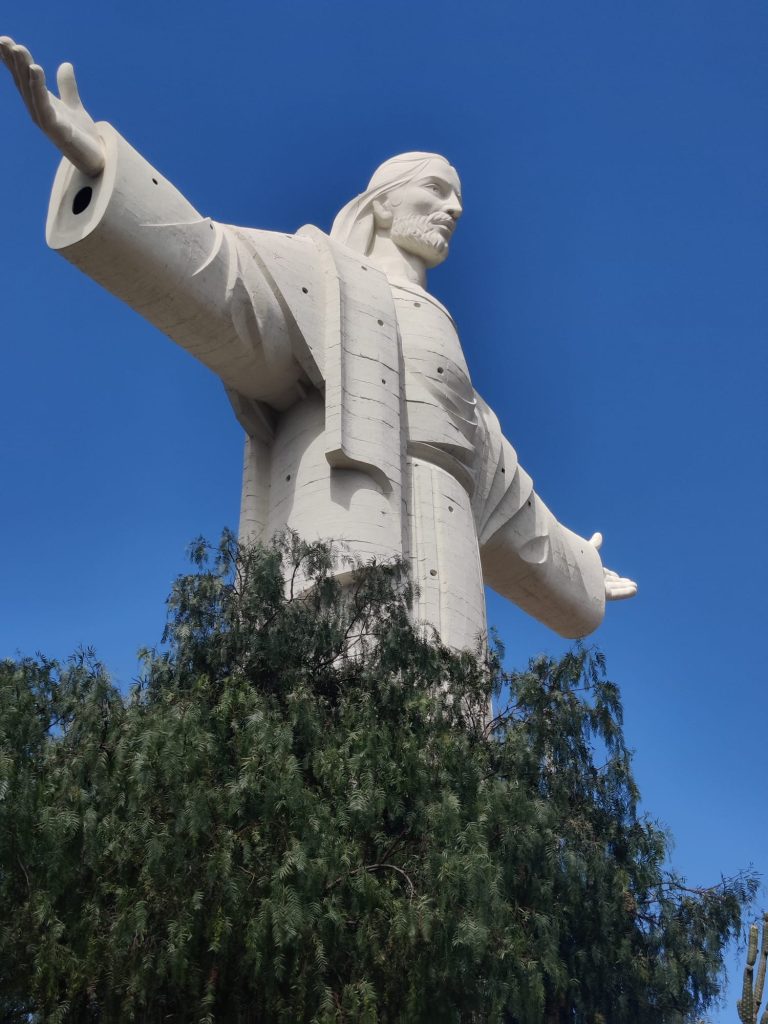Cochabamba is Bolivia’s fourth largest city, after Santa Cruz, El Alto and La Paz. It is commonly known as the City of Eternal Spring, due to it’s year-round spring-like temperatures. Our time there lived up to this reputation, as we enjoyed sunny days and refreshing nights – exactly what you want living in a camper van!
Having found a suitable place to park and sleep with our vehicle (a car wash owned by the wonderfully named Angel!), we headed into the city centre on foot. The city was a hive of activity in the evening with vehicles and pedestrians everywhere the eye could see. We strolled a few streets before hunger called and we settled on some local cuisine that went down a treat. We then went to the main plaza where a big screen was setup to show a recently released movie called “La Lucha” (The Fight).
The movie detailed the 2016 protests by disabled Bolivians, first in Cochabamba and then in other areas of Bolivia. They demanded a basic monthly income from the State totalling 500 Bolivianos ($97) per month, less than a third of the minimum wage. Faced with rejection, the protesters organized a caravan of wheelchairs that wheeled the 460km all the way to La Paz. On arrival, after extensive government repression and discriminatory propaganda, the protesters continued to camp in the capital for over 100 days fighting for their rights. Following intervention at a United Nations level, the government eventually agreed to partly provide financial assistance for the protesters.
I digress with the above as we were so moved by the movie, the setting and the people involved (some of whom were in the audience for the screening), that I think it is worth detailing in more detail.
The next day we set our sights on the “Cristo de la Concordia” or Christ The Redeemer Statue in the city. Not just any statue, it is the largest such statue in the world, measuring 34 meters high with amazing views of both the sprawling city and the Tunari Mountain Range. Located on Cerro de San Pedro, pedestrain access requires scaling a whopping 1600 steps. I must admit, I hugely enjoyed the hike up the steps, however I can appreciate it may not be for everyone. There is the option to take a taxi straight up, but sure where is the fun it that?!!
ToroToro National Park is located a couple of hours from Cochabamba. While being the smallest national park in the country, it more than makes up for it with attractions that include canyons, caves, dinosaur footprints and fantastic treks.
After squeezing our vehicle into the small town of the same name, we organised our trekking guide for the next couple of days. We are not a family who usually does an activity if a guide is required, however in the national park this is a must. Alejandro was superb however, spending two days bringing us in an out of beautiful canyons and otherworldly caves (helmets and torches even required for the caves), and even finding a plethora of dinosaur footprints for us to admire. We loved everything about the park, the town and the whole experience there. Certainly a detour worth making from Cochabamba.
La Paz is a city I had previously visited and was eager to return to. Following a couple of days driving, we made it to the outskirts of the hectic city and parked our camper van for a number of days. We would stay in a central hotel with my parents, who were coming to visit us.
We spent our first full day visiting the city via the hugely impressive cable car system. This allowed us to appreciate the amazing geography of the valley, alongside the architecture that is uniquely that of La Paz. Following a walk to the Plaza Murillo and a visit to a local church and art gallery, we ended the day with a delicious meal in a local cafe close to where we were staying (beside the Plaza Isabel La Catolica).
The next day we visited the Basilica San Francisco before some lunch in the Cafe Del Mundo, a wonderful place full of colour, life and general good vibes. The small Cocoa Museum then provided quite a lot of learning for grandparents, grandchildren, and parents alike! A stroll through “El Mercado de las Brujas” or Witches Market followed but I must say that we were a little underwhelmed by this particular experience.
The following day proved to be my last sightseeing day in La Paz unfortunately. After a great morning at the very impressive Valle de la Luna (Moon Valley), I became ill and had to spend the following few days in the hospital. All ended well though as I made a full recovery and was ready to hit the road to our last destination in Bolivia.
Copacabana can only be reached via La Paz by taking a tiny ferry across the Strait of Tiquina. Given the size of our vehicle, this was heart in the mouth stuff at times. However we need not have feared the local transport infrastructure, we arrived on dry land without issue and continued our trip to Copacabana on Lake Titicaca.
Due to our delayed exit from La Paz, we could not visit the famous “Isla del Sol” or Sun Island (we had concurrent hotel bookings further north in Peru that could not be amended unfortunately). This was disappointing for us all, but we still managed to enjoy the quaint town centre and sample some of the locals delicacies.
This ended our time in Bolivia. Despite some of the challenges that we had faced, we left the country wanting more and looking forward to the day that we would come back!











